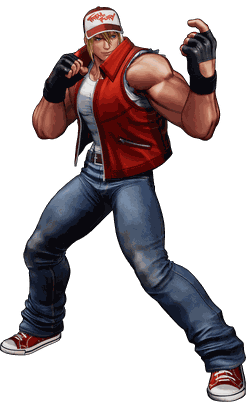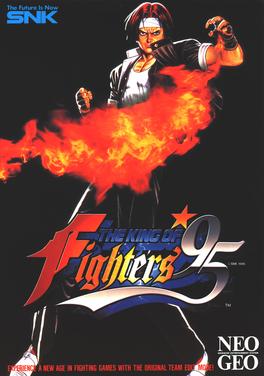The King of Fighters (KOF) is a series of fighting games by SNK that began with the release of The King of Fighters '94 in 1994. The series was developed originally for SNK's Neo Geo MVS arcade hardware. This served as the main platform for the series until 2004 when SNK retired it in favor of the Atomiswave arcade board. Two King of Fighters games were produced for the Atomiswave platform (The King of Fighters Neowave and The King of Fighters XI) before SNK decided to discontinue using it for the series. The series' most recent arcade hardware is the Taito Type X2, first used with the release of The King of Fighters XII. Ports of the arcade games and the original The King of Fighters games have been released for several video game consoles. The latest entry in the series, The King of Fighters XV, was released in February 2022.

SNK Corporation is a Japanese video game hardware and software company. It is the successor to the company Shin Nihon Kikaku and presently owns the SNK video game brand and the Neo Geo video game platform, and electronics. SNK's predecessor Shin Nihon Kikaku Corporation was founded in 1978 by Eikichi Kawasaki. In 1981, the name was informally shortened to SNK Corporation, which became the company's official name in 1986.

Art of Fighting is a fighting video game trilogy that were released for the Neo Geo platform in the early 1990s. It was the second fighting game franchise created by SNK, following the Fatal Fury series and is set in the same fictional universe as a prequel to the Fatal Fury series. The original Art of Fighting was released in 1992, followed by two sequels: Art of Fighting 2 in 1994 and Art of Fighting 3: The Path of the Warrior in 1996.

Terry Bogard is a fictional character created by SNK as the protagonist of their Fatal Fury series. Introduced in Fatal Fury: King of Fighters in 1991, he is an American fighter who enters the worldwide "The King of Fighters" tournaments to combat his father's murderer, Geese Howard. Following Geese's defeat, Terry becomes the guardian of Geese's son Rock Howard. He is also a regular character in the crossover video game series The King of Fighters, where he continues participating in tournaments. He has also been a guest character in other games, including the Capcom vs. SNK series, Arika’s Fighting EX Layer and Nintendo's crossover fighting game Super Smash Bros. Ultimate. In addition to video games, Terry has appeared in anime films based on Fatal Fury, and manga serialized in Comic Bom Bom.

Sengoku is a beat 'em up arcade game. It is the first entry of the Sengoku trilogy by SNK. It was ported to numerous home consoles including the Neo Geo, Neo Geo CD, Mega-CD and Super Famicom. The arcade version was part of SNK Arcade Classics Vol. 1, released in 2008. The Neo Geo version was re-released on the Japanese Virtual Console in 2011, with the sequels for the North American Virtual Console on November 8, 2012 and June 6, 2013 and for the PAL region on February 7, 2013 and September 5, 2013. In 2009 the series was compiled on the Sengoku Anthology for PlayStation 2 and Windows.

The King of Fighters '95(KOF '95) is a fighting video game developed and published by SNK for the Neo Geo arcade and home consoles in 1995. It is the sequel to The King of Fighters '94 and the second game in The King of Fighters series. It is also the first game in the series to be ported to other home consoles besides the Neo Geo AES and Neo Geo CD with versions released for the PlayStation, Sega Saturn, and Game Boy.

The King of Fighters '97(KOF '97) is a fighting game produced by SNK for the Neo Geo arcade and home console in 1997. It is the fourth game in The King of Fighters series. It was ported to the Neo Geo CD, as well as the PlayStation and the Sega Saturn in Japan only.

The King of Fighters '99: Millennium Battle is a 1999 fighting game developed and published by SNK for the Neo Geo MVS arcade and home consoles in 1999. It is the sixth installment in The King of Fighters series, introducing a new story arc known as the "NESTS Chronicles" which is centered around a young man named K', who is formerly associated with a mysterious yet threatening organization known only as NESTS. The game introduces several changes to the established KOF format, most notably an assisting character labeled "Striker". The game was ported to the Neo Geo CD and the PlayStation. Dreamcast and Microsoft Windows versions were also released under the title The King of Fighters' 99: Evolution whose stages were remodeled in 3D.

Fatal Fury 2, known as Garō Densetsu 2: Aratanaru Tatakai in Japan, is a 1992 fighting video game released by SNK for the Neo Geo arcade and home platforms, and later ported to several other home systems. It is the sequel to Fatal Fury: King of Fighters (1991) and the second game in the Fatal Fury franchise. Its updated version, Fatal Fury Special, was released in 1993.

World Heroes 2 is a 1993 fighting arcade game developed and published by ADK with the assistance of SNK. It was originally released for the Neo Geo MVS arcade cabinet on April 26, 1993. It is the sequel to the 1992 fighting arcade game World Heroes, as well as the second title of the World Heroes series. It was even the first game with the "ADK" logo labeled within the game after the developer changed from its previous name "Alpha Denshi"; however, the "Alpha" logo was last used on one of the arcade flyers of World Heroes 2.

The King of Fighters XI(KOF XI) is a 2D fighting game produced by SNK Playmore. It is the eleventh installment in The King of Fighters series following The King of Fighters 2003. It was originally released as a coin-operated arcade game for the Atomiswave platform in 2005. A home version for the PlayStation 2 was released in Japan in 2006, followed by releases in the PAL region and North America in 2007. It is the second The King of Fighters game to not run on the Neo Geo following its predecessor, The King of Fighters Neowave and also the first major canonical entry to not be named after its year of release.

Garou: Mark of the Wolves is a 1999 fighting game produced by SNK, originally for the Neo Geo system and then as Fatal Fury: Mark of the Wolves for the Dreamcast. It is the eighth installment of the Fatal Fury series.

The King of Fighters '96(KOF '96) is a fighting game released by SNK for the Neo Geo arcade and home consoles in 1996. It is the third game in The King of Fighters series, following The King of Fighters '95. Like its predecessor, the game was ported to the Neo-Geo CD, as well as the PlayStation and Sega Saturn. Unlike the previous game, the PlayStation and Saturn versions were released only in Japan, with a language setting allowing the player to set the game to English.
The King of Fighters 2001(KOF 2001, or KOF '01) is a fighting game produced by Eolith for the Neo Geo. It is the eighth game in The King of Fighters series, the third and final part of the "NESTS Chronicles" story arc, and the first game produced following the closure of the original SNK. The game was produced by the South Korea-based company Eolith and developed by Eolith and BrezzaSoft, a company formed by former SNK employees. For this reason, the SNK logo is displayed at the opening, but SNK's development staff is not involved in the production of the game itself at all, except for the game sound. Due to the influx of Korean capital, its influence can be seen in the participating characters. The game was ported to the Sega Dreamcast in Japan only and PlayStation 2. The stand-alone PlayStation 2 version was released in North America and in Europe in a two-in-one bundle with the preceding game in the series, The King of Fighters 2000. Both the original Neo Geo version and the Sega Dreamcast version were included in The King of Fighters NESTS Hen compilation released for the PlayStation 2 in Japan.

The King of Fighters 2000 is a fighting video game that was produced by SNK for the Neo Geo arcade and home consoles in 2000. It is the seventh installment in The King of Fighters series for the Neo Geo and the final game in the series SNK produced before the original company's bankruptcy. The game was ported to the Dreamcast and the PlayStation 2 in 2002. The game's story, a sequel to The King of Fighters '99 and the second part of the "NESTS Chronicles" story arc, focuses on a new tournament held by the commander of the Ikari Warriors, Heidern, who seeks to capture and interrogate former NESTS agents K' and Maxima into revealing crucial and critical information about the NESTS cartel. The gameplay retains the Striker system of the previous games in the series, but the assisting character can also cooperate with the playable character to generate combos.
The King of Fighters 2003(KOF 2003, or KOF '03), also known by fans as The King of Fighters X, is a fighting game produced by SNK Playmore for the Neo Geo arcade and home platforms in 2003. It is the tenth game in The King of Fighters series and the last one released for the Neo Geo, which served as the primary platform for the series since The King of Fighters '94. It was ported to the PlayStation 2 and Xbox, and was released on both consoles in North America in a two-in-one bundle with the preceding game in the series, The King of Fighters 2002.

The Super Spy is an early Neo Geo game released by SNK in 1990. It is a first-person shooter and beat 'em up game with action role-playing elements in which players move through the many floors of an office building shooting terrorists. It is a first-person game where the player character's arms and weapons are visible on screen. In 1991, ADK's Crossed Swords had similar gameplay, but with more role-playing elements and hack & slash combat instead of shooting and fist-fighting.

Samurai Shodown, known in Japan as Samurai Spirits, is a fighting game developed and published by SNK for the Neo Geo arcade and home platform. Released in 1993, it is the first installment in the Samurai Shodown series. In contrast to other fighting games at the time, which were set in modern times and focused primarily on hand-to-hand combat, Samurai Shodown is set in feudal-era Japan and was SNK's first arcade fighting game to focus primarily on weapon-based combat.

King of the Monsters 2 is a fighting/wrestling game released on May 5, 1992 by SNK. It is a sequel to the 1991 game King of the Monsters. In this game three of the previous game's surviving monsters return and battle across the Globe against giant alien monsters that threaten the Earth. The game was later ported to the Super NES and Sega Genesis by Takara.

ZuPaPa! is a platform arcade video game developed by Face and originally published by SNK on September 1, 2001. Starring the eponymous creature, players are tasked with travelling through nine stages, throwing small creatures called Zooks, jumping on and off platforms to navigate level obstacles while dodging and defeating monsters. Although first launched in arcades, the game has been re-released through download services for various consoles. The title has gained a cult following since its initial release.


















